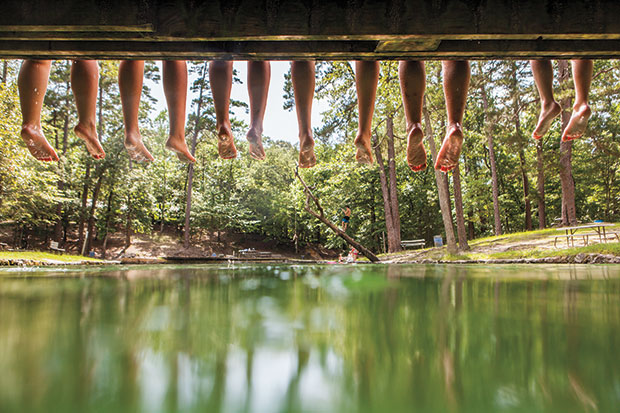
Tonkawa Springs in Garrison.
Glinting pools of blue-green water. Rugged limestone bluffs, fuzzy with moss. A rope swing, knotted for better grip, looped over the branch of a towering tree.
Explore more beautiful Texas swimming holes, including Austin’s Barton Creek and Lampasas’ Hancock Springs, at texashighways.com/webextra.
In Texas, we love our swimming holes as much as we love barbecue and country music.
We’ve got plenty of them worth bragging about, too. From east to west and north to south, shimmering natural ponds and river respites abound, beckoning us to kick off our sandals and take a flying leap.
Our advice? Give in to the temptation. To help you plot your adventure, we’ve rounded up a few of our favorites.
But nature has a way of taking away what she gives, and swimming holes are fickle things. What you see today could shrink like a grape into a raisin in a few short weeks. If you’re itching to dangle your toes in some glorious, nature-made aquariums, do it while you can.
Just remember to take some precautions. Lifeguards aren’t on duty in many of these spots. Make sure you know how to swim, and don’t dive into shallow water or anywhere you can’t see the bottom. Never swim alone. Wear appropriate footwear—many of our picks require short but sometimes tricky hikes.
And while some of these places close just after a heavy rain because of flooding or runoff pollution, recent rainy seasons have also recharged many Texas swimming holes with cool, refreshing water.
–––––––
 The perfect place to perfect a cannonball? It’s hard to argue against the wooden swim platform 30 yards offshore from the pine-rimmed lake at Daingerfield State Park.
The perfect place to perfect a cannonball? It’s hard to argue against the wooden swim platform 30 yards offshore from the pine-rimmed lake at Daingerfield State Park.
Daingerfield State Park is at 455 Park Rd. 17, two miles east of Daingerfield. Call 903/645-2921.
The woodsy, 506-acre park in far northeast Texas opened in 1938. The Civilian Conservation Corps built an earthen dam in the Cypress Creek drainage to create the lake, then added a combination bathhouse and concession building, a boathouse, and a small fishing lodge. Three smaller cabins were added later, and they’re available for rental.
In the 1940s and ’50s, teenagers flocked here to swim in the lake and dance to music from a jukebox on hot summer nights. Pine trees tower high over the campsites, swaying in the wind and dropping cones and needles that create a springy carpet.
But the lake remains the focus. On warm days, kids drape themselves over the floating deck like turtles on a log. Visitors can rent canoes, kayaks, or paddleboats from the old boathouse, or buy a candy bar or rent horseshoes from the park store.
Also popular is fishing for chain pickerel, largemouth bass, catfish, brim, and crappie. Motorboats are permitted, but they can only putter; no wakes are allowed.
–––––––
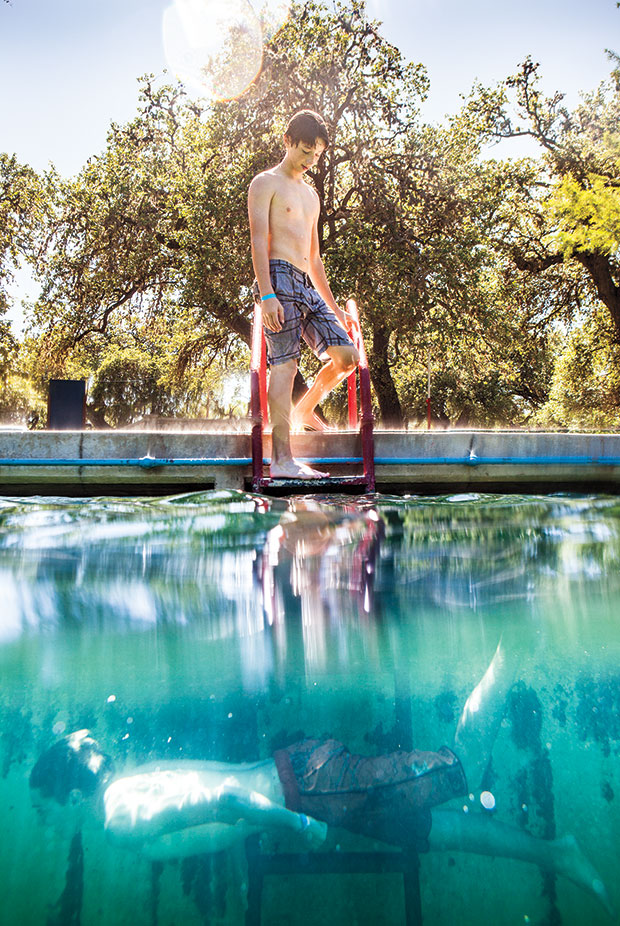
Fort Clark Springs
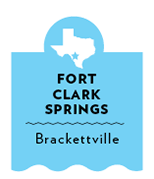
A sign greets visitors as they cross a stream of water on their way to the shimmering pool tucked amid shady live oak, pecan, cypress, and mulberry trees at Fort Clark Springs: “When you cross Las Moras Creek, your sins are washed away.”
Fort Clark Springs is on US 90 in Brackettville. Call 830/563-2493.
In case that doesn’t work out, count on a dip in the expansive pool for an equally cleansing experience. Fort Clark bills the 1-million gallon, can’t-believe-it’s-in-the-middle-of-the-southwest-Texas-scrubland oasis as the third-largest spring-fed swimming pool in the state. It has a cement bottom, plus a bathhouse for changing and benches and picnic tables for lingering.
Some contend the water temperature stays a constant 68 degrees year-round, but it often feels a few degrees warmer, which makes it perfect for lollygagging, and there’s ample room for logging long, leisurely laps.
It’s got history, too. George S. Patton Jr. probably once swished his toes in these waters. Long before he became a general, he served briefly as regimental commander of the Fifth Cavalry at this old frontier fort, which dates to the 1850s.
The homeowners association that manages Fort Clark recently discontinued day passes for the swimming pool, but visitors who stay in the fort’s RV park or the old cavalry barracks, now converted to a motel, are allowed pool access.
–––––––
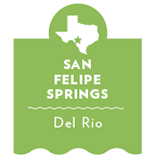
Ten separate springs percolate along San Felipe Creek, just upstream from its confluence with the Rio Grande in Del Rio. The clear water that gurgles forth supplies the city of Del Rio and nearby Laughlin Air Force Base—and feeds a more-than-a-mile-long strip of urban parkland with pools and streams perfect for escaping the South Texas heat.
Access Horseshoe Park from US 90 in east Del Rio. The springs are free and open to the public. Call 830/774-8541.
Stone walking bridges crisscross the creek’s three tributaries, which twist like braids but ultimately merge into one main flow, bordered by a paved hike-and-bike trail that leads from Horseshoe Park to Lions Park. Perch on rocks scattered in the main fork in the shadow of an old metal railroad bridge, or climb on an inner tube (bring your own) for a lazy, water-fueled ride downstream. Locals call another section that’s popular with children the Pig Pen. Those who like their swimming a little less wild can drop by the spring-fed, cement-bottom Moore Park Pool ($1.50 for entry).
–––––––
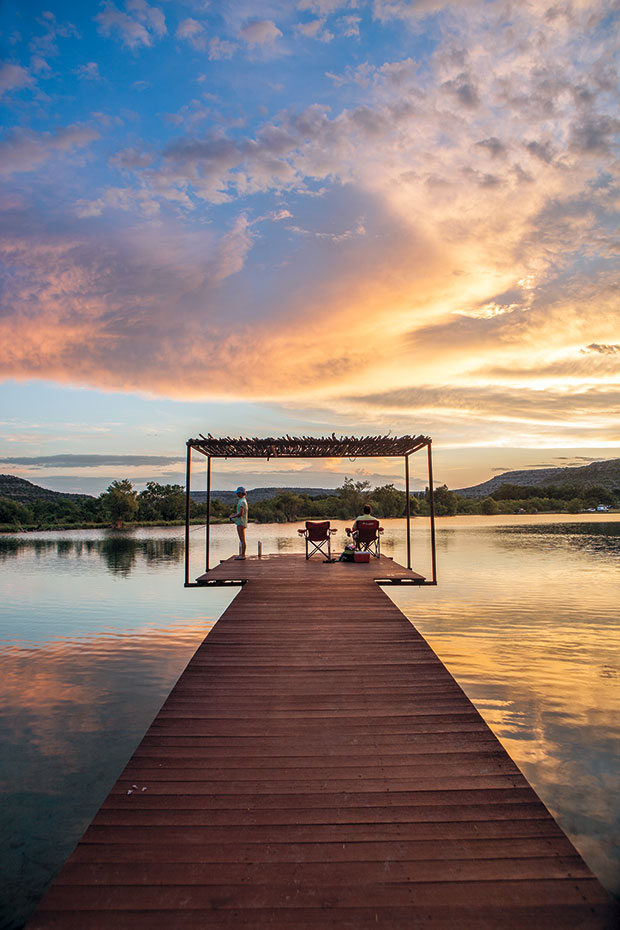
Independence Creek Preserve
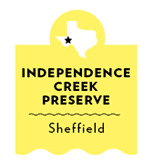
The water sparkles so clearly in this magical desert swimming hole you could be in the Bahamas.
The preserve opens only during occasional public weekends, held a few times per year. The next is set for September 10. On those days, there’s no charge to camp, fish, hike, or swim. Call 432/345-6773.
But you won’t find crowds of sunbathers or swaying palms here. Instead you’ll see deep-cut canyons and scrub-covered mesas, and just out of eyesight lies a prairie-dog village with fat little pups that pop up their heads and chirp an alert when anyone strolls past.
It’s all part of a 20,000-acre chunk of West Texas purchased by the Nature Conservancy for water quality protection and habitat conservation. The land lies in the transition zone between the Edwards Plateau and the Chihuahuan Desert, near the town of Sheffield.
Caroline Spring, located at the preserve’s headquarters, produces 3,000 to 5,000 gallons of water per minute. That water, held in check by a small dam, forms two lakes—a three-acre pool with a stone retaining wall along one side and a more natural 11-acre one. You’ll have to fight the ducks for space on the wooden dock on the larger lake, which provides the perfect place to stage a diving competition.
Water that passes through the lakes washes into Independence Creek, which flows into the Pecos River less than a mile downstream.
–––––––

A small dam 11 miles downstream from the headwaters of the Sabinal River creates a wide, tempting swim spot in the aptly named Hill Country town of Utopia.
Utopia Park is at 241 Utopia Park Rd. Admission is $5 per day per car (free to area residents). Call 830/966-3643.
Arrive early to nab a picnic table nestled in the thick oaks next to the parking area. Then scramble down the riverside slope, where a row of towering old cypress trees lines the banks.
Brave souls climb a makeshift ladder nailed to the tallest one and plunge into the cool waters far below. Less daring visitors float like otters in the tranquil, emerald-green bliss. When they need a break from swimming, they can wander over to the bird blind at the end of the park’s circle drive.
The main draw? Besides enough trees to please a county’s worth of woodpeckers, it’s all about that broad, glistening expanse of water. It’s not just for dipping toes—swim-a-holics can get in a real workout stroking up and down the length of the pool.
Public restrooms are available, and tent camping and fishing are allowed. Rustic screened shelters are available for rental.
–––––––
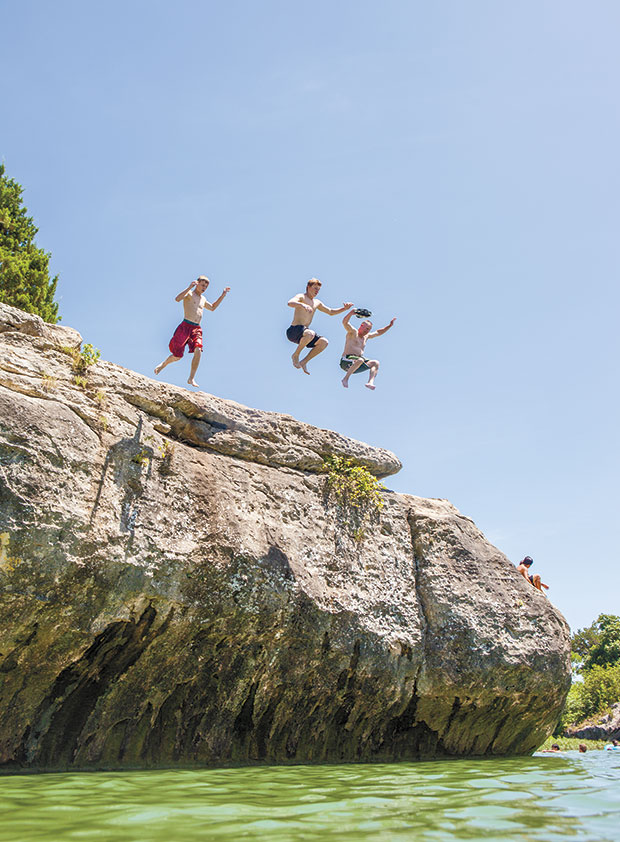
Tonkawa Falls
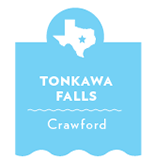
A half-mile east of the tiny town of Crawford, a two-lane bridge crosses Tonk Creek. From there, you can just glimpse Tonk Park, the lush city park below, where water spills over a 15-foot limestone embankment and forms a pool perfect for frolicking.
Tonkawa Falls is at 8540 E. Fifth St. in Crawford. Admission is free. Call Crawford City Hall, 254/486-2125.
Above the falls, hikers hop rock to rock or wade in ankle-deep water. On the other side of the road, they gather in an old rock clubhouse or meander down stone steps constructed by the Works Progress Administration in 1934. There, a rock overhang provides a cool respite from the sun.
Some bathers spread towels on the grassy expanse next to the water, where they can watch daring teenagers jump from the surrounding bluffs. Others drift further downstream.
Tonkawa Indians once inhabited the area, and excavations have turned up hundreds of artifacts. In dry years, the swimming hole evaporates by late summer. When the water vanishes, petroglyphs carved into the rock bed of the creek appear.
–––––––
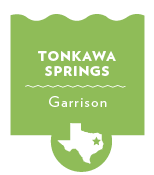
This idyllic spring-fed pond, nestled within the East Texas Piney Woods, draws visitors who can’t resist the lure of ice-cold water, a white sandy bottom, and a good rope swing.
Camp Tonkawa Springs is at 4675 County Rd. 153 in Garrison. Entry costs $10 per person age six and older; $5 on Wednesdays, family day. Call 936/564-8888.
That swing, by the way? Notches in a tree that slants over the water serve as steps, making it easy to grab the rope and launch into water that hovers around 68 degrees. From there, you may as well kick back a while and contemplate this place’s colorful history.
In the early 1900s, the springs turned a wheel that operated a gristmill here. The Civilian Conservation Corps built stone retaining walls around the spring in the 1930s, which was when the Boy Scouts began leasing the property. Troops flocked to the site for campouts until the 1960s. When they left, organized fox hunts took place at the site. Then, in the 1980s, the Ozarka Water Company pumped water from the springs.
The spring’s owners opened the pool as a park in 2001, complete with a campground and RV hookups, and a new generation is lazing away summer days playing Marco Polo in its waters.
–––––––
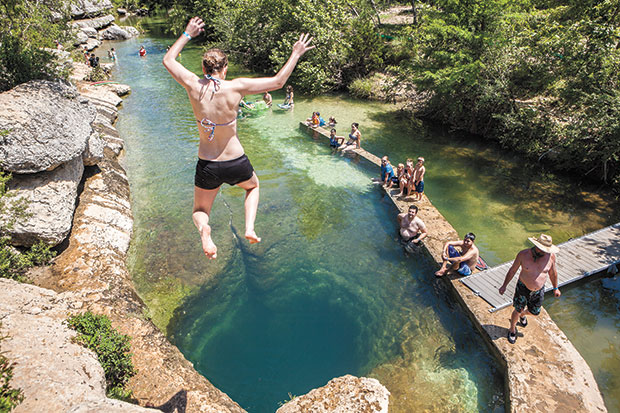
Jacobs Well
 With its vibrant, deep-blue hue and circular shape, the namesake artesian well at this popular Wimberley swimming hole looks a little like the Texas version of one of Yellowstone National Park’s colorful thermal pools.
With its vibrant, deep-blue hue and circular shape, the namesake artesian well at this popular Wimberley swimming hole looks a little like the Texas version of one of Yellowstone National Park’s colorful thermal pools.
Jacob’s Well Natural Area is at 1699 Mount Sharp Rd. in Wimberley. To control crowds, the county requires online reservations, available at jwna.checkfront.com/reserve. Entry costs $9 for adults and $5 for Hays County residents, children, seniors, and military. Call 512/214-4593.
It’s pure Texas, though.
The spring feeds Cypress Creek and the Blanco River, and the goosebump-inducing, clear-as-glass water draws big crowds on warm summer days.
Some sunbathe on limestone cliffs that surround the swimming hole. Though it’s against park rules, the bravest fling themselves off those rocks toward the cave opening, a 12-foot gap so deep and dark you can’t see the bottom. The rest sit in a foot of water around the perimeter or try to see how far into the abyss they can swim.
Jacob’s Well is part of one of the deepest underwater cave systems in Texas. The main shaft plunges down 137 feet, with branches that twist off in every direction. (Scuba diving is prohibited in Jacob’s Well. At least eight people died while trying to explore the underground network before Hays County took over the property in 2010, tearing down condominiums and the remains of an old RV park that once stood a stone’s throw from the creek.)
–––––––
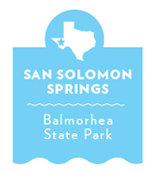
Edging your way along the high dive above San Solomon Springs at Balmorhea State Park, you’ll feel like a pirate walking a plank. Fear not, though, the crisp waters of San Solomon Springs provide the perfect landing spot.
Gliding across this huge V-shaped pool with a natural bottom is like swimming in a giant aquarium. Ducks bob on the surface, then plunge like submarines into waters that are home to two thumb-sized species of endangered fish—the Comanche Springs pupfish and the Pecos Gambusia. Look closely and you’ll also see catfish swirling 20 feet below.
The site has long attracted people. American Indians, Spanish explorers, and U.S. soldiers watered up here well before the Civilian Conservation Corps turned a desert wetland into a swimming pool in the 1930s. Private concessionaires operated the park until the 1960s, when the Texas Parks and Wildlife Department took over. On hot summer weekends, the park fills to capacity by noon and cars are turned away.
The springs that form the pool pump out about 15.5 million gallons of water a day; the spring water is diverted by three-foot canals to Balmorhea Lake, two miles away, and used to irrigate alfalfa and watermelon fields.
Visitors can stay in the adjacent, 18-unit San Solomon Springs Courts motel, also built by the CCC, or pitch a tent in the nearby campground (RV hookups available).
Balmorhea State Park is at 9207 Texas 17 in Toyahvale. Admission costs $7 for visitors age 13 and older. Call 432/375-2370.
–––––––
Hancock Springs, Lampasas
Hancock Park is on US 281 South. Entry to the pool, which opens June to September, costs $3.50 for visitors ages 13 and up, $2.50 for children ages 3-12 and seniors over 55. Call 512/556-4048.
Back in the 1880s, Lampasas billed itself as the Saratoga of the South, and the local mineral springs became a health resort and tourist attraction, drawing people to soak in the healing waters.
In 1911, crews excavated a man-made swimming pool and built a dance pavilion and changing room. Over the next century, the pool drew soldiers from nearby Fort Hood, visitors who came to watch big band concerts at the historic Hostess House overlooking the pool, and throngs of kids clutching beach balls and inflatable rafts.
The city eventually paved the pool’s gravel bottom and renovated the restrooms, but other than that things haven’t changed much in the past 100 years.
Today an average of 450 gallons of chilly water flow each minute from the springs into the curved pool, which measures eight feet deep in the center and three feet at its most shallow point. Some people still bring jugs to fill at the spring’s mouth, adjacent to the pool. Floats are allowed, and guests can bring picnics or relax in the wooden gazebo.
During full moons in the summer, the pool hosts moonlight swim parties (August 13 is the final one this season) with live music and a potluck supper. In the winter, hardy souls shed their down jackets for the annual polar bear plunge.
–––––––
Barton Creek, Austin
Access Twin Falls from the southbound access road of MoPac Expressway (Loop 1), near the intersection with Loop 360. For Gus Fruh, go to the Barton Creek Greenbelt access at 2642 Barton Hills Dr. For Campbell’s Hole, park at the west end of the Barton Springs parking lot and walk about a mile upstream from the trailhead. Barton Springs Pool is at 2201 Barton Springs Rd. For Barton Creek, call Austin Parks and Recreation, 512/978-2600. For Barton Springs, call 512/867-3080.
Barton Creek forms a series of popular swimming holes, like charms on a necklace, as it weaves its way through the Hill Country toward the Colorado River and downtown Austin.
If you stretch your neck just so, you can catch a glimpse of cars roaring by on MoPac Expressway from the boulders that frame Twin Falls, a popular swimming spot on the creek. But you still feel miles from the city.
After a good rain, water courses over those limestone rocks, spilling down a four-foot ledge into a deep pool that almost always has enough water for a decent swim. Wear shoes or sandals you can get wet, because the rocky terrain can wreak havoc on tender feet. Expect to find clear, crisp water, and, on hot weekends, a big crowd. You’ll have to work a bit to get there—it’s a half-mile hike from the MoPac feeder road, much of it over rocky terrain.
Farther east, at Gus Fruh Park, the sometimes ankle-deep water transforms into nature’s version of an Olympic-size swimming pool in wet years. There’s even a rope swing, where you can launch yourself from a tree on the bank and swing, pendulum-like, over the olive green water.
And Campbell’s Hole, closer to Zilker Park, features a small, stony beach. According to local, unconfirmed lore, Robert E. Lee and outlaws Sam Bass, Jesse James, and Bonnie and Clyde all visited the spot.
The creek’s series of swimming holes culminates at Barton Springs, the granddaddy of them all, one of Austin’s biggest attractions and where every University of Texas student, hippie, musician, and slacker heads to chill out.








